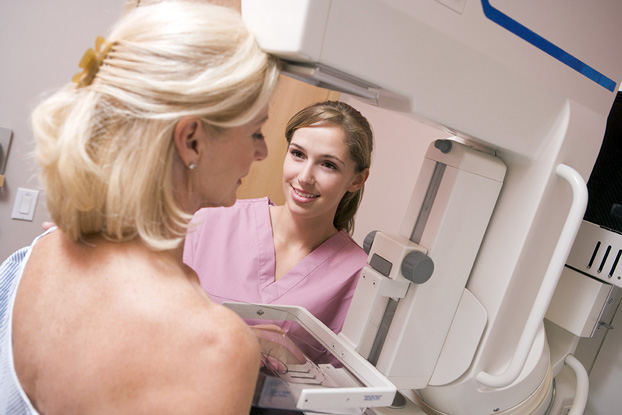Why should I do a monthly self-breast exam?
 A monthly self-breast exam (SBE) is part of a three-part breast health arsenal every woman needs to use to be on guard against breast cancer. The SBE is an inspection of your breasts to increase your awareness of how they look and feel when you are in good health so that you can report any changes or concerns to your doctor. Monthly self-exams also let you take action to help protect yourself against cysts, cancers and infections that affect the breasts.
A monthly self-breast exam (SBE) is part of a three-part breast health arsenal every woman needs to use to be on guard against breast cancer. The SBE is an inspection of your breasts to increase your awareness of how they look and feel when you are in good health so that you can report any changes or concerns to your doctor. Monthly self-exams also let you take action to help protect yourself against cysts, cancers and infections that affect the breasts.
Monthly self-exams let women be more comfortable with their bodies, and able to provide vital information to their doctors at their yearly physical exams. The monthly BSE should be done along with annual clinical breast exams at the doctor’s office and mammograms according to the recommended schedule.
Up to 40 percent of breast cancers are initially detected by women who felt a lump at home during a self-exam, according to Johns Hopkins Medical Center. Clinical breast exams and mammograms help diagnose the nature of lumps and other abnormalities, and they are the other two vital parts of the three-part breast health arsenal.
Women should become familiar with the look and feel of their breasts, and report any changes or concerns immediately to their doctors. Most changes women note at home are eventually determined to be benign, but some changes do indicate something more serious is happening. Early detection of a problem is the key to successful resolution.
When should I start doing self-breast exams, and what time of the month is best to do them?
Every woman should be doing breast self-exams by the time she is 20. Adult women of all ages should continue doing them once a month. Establishing a monthly routine for breast self-examination is vital for your health.
The best time to do your monthly self-exam is when your breasts are not tender. Your hormones fluctuate throughout the month during your menstrual cycle, which can cause your breasts to be tender and swollen. Usually, your breasts are least tender a few days after the end of your period. This is the best time to do your self-exam. If your periods are irregular, doctors suggest doing your SBE on the same day every month, so you always remember the exam.
How do I do the breast self-exam?
Do all three exams on the same day.
Start by visually examining your breasts.
- Stand or sit topless in front of a mirror with your arms limp at your sides.
- Face forward. Look at your breasts and note any dimpling, puckering of the skin, or changes in breast size, shape or symmetry.
- Note whether your nipples are inverted (turned in).
- Press down on your hips with your hands and inspect your breasts for the same things as above.
- Raise your arms over your head. Press the palms of your hands together. Examine your breasts again, using the same checklist above.
- Raise your breasts with your hands. Check to see that any ridges underneath are symmetrical.
Examine your breasts with your hands
- First, examine your breasts in the shower or bath.
- Lather your hands and your breasts. This helps your fingers slide over your skin.
- Use a circular motion to identify areas of your breasts. Get to know how each breast feels.
- Eventually, you will know each breast so well that any changes are immediately apparent to your hands.
- After your bath or shower, and on the same day, examine your breasts lying down.
- Lie on your back on a bed or other flat surface. This lets your breast tissue spread out.
- When you are lying flat, your breast tissue is thinner and becomes easier to feel.
- By checking your breasts in several positions, you learn far more about how your breasts feel.
General tips to help with your breast self-exam
- Use the pads, not the tips, of your three middle fingers. These are the most sensitive parts of your fingers. You can also use your palm or the backs of your fingers if you must.
- Use different pressure levels for each area of the breast. You want to feel different levels of your breast tissue. Start with light pressure to check the tissue closest to the skin, then move to medium pressure to feel deeper tissue, and finish with firm pressure to feel the breast tissue that lies closest to your ribs. Use each pressure level on each area of the breast before moving on to the next area.
- Do not rush during your breast self-exam. It will take several minutes to do each stage of your breast exam.
- Follow a methodical pattern and technique to examine your entire breast. Some women imagine their breast as the face of a clock or slices of a pie so they can ensure they examine every area.
- Start close to your collarbone and thoroughly check that section, moving your fingers towards your nipple. Once that section is complete, move your fingers to the next section.
What is normal?
Most women have lumps and other changes in their breast over time and at different times in their menstrual cycles. Breasts are often not the same size or shape, and nipples may not always point in the same direction. It is also normal to detect a firm ridge along the bottom of each breast.
As you have children and as you age, the appearance and feel of your breasts will also undergo normal changes. Discovering a lump or other change in your breast during your monthly self-exam is not necessarily a reason to panic immediately. Many conditions other than cancer can cause changes in your breasts.
Why isn’t my yearly breast exam at the doctor’s office enough?
Many doctors believe breast self-exam is an essential screening strategy when used in combination with regular exams by your doctor and mammograms according to the recommended schedules. They strongly recommend all women perform BSEs, get yearly clinical exams from their doctors and follow the mammography exam recommendations.

The Mayo Clinic reports a “significant” number of women found the first signs of breast cancer through BSEs. Most doctors feel women should be familiar with their bodies and breasts to understand what is normal and so they can report changes or concerns. Anything that looks or feels out of the ordinary warrants a call to the doctor.
Our recommendation at Kansas City ObGyn is to combine regular self-exams with annual check-ups with your gynecologist, and to get annual mammograms after age 40.
Are there specific warning signs to look for during a breast self-exam?
Often, women who perform monthly breast self-exams have questions. For this reason, our gynecologists are happy to guide you through your first self-exam. They can teach you how to do the exam and help you learn what is normal or abnormal in a breast self-exam. Learning to do a breast self-exam properly can save your life because breast cancers caught and treated early are more often curable.
Most abnormal findings in breast self-exams are non-cancerous. Still, anything out of the ordinary needs to be checked by your doctor, because you may have an infection or another issue with your breast that needs treatment.
See your doctor if you notice any of the following during your monthly breast self-exam:
- Any hard knot or lumps near your underarm
- Any changes in the way your breast looks or feels
- Any thickening or prominent fullness in the breast tissue that is different from surrounding tissue
- Any bulges, ridges, puckers or dimples that appear on your breast skin
- Any changes in your nipple causing it to be inverted (pushed in) rather than sticking out
- Redness, pain, swelling or warmth anywhere on, in or around your breast
- Skin changes on your breast, such as rashes, sores, scaliness or itching
- Nipple discharge, including bloody discharge
The doctor will probably do a clinical breast exam and may order more tests to investigate these changes. The tests may include blood tests, an ultrasound of the breast or a mammogram. The doctor may also want to do a procedure called a biopsy, where a small piece of the suspicious breast tissue is removed and examined in a laboratory.
What is the difference between a breast self-exam and a clinical breast exam?
A healthcare professional like your doctor or their nurse performs a clinical breast exam. They are trained to spot warning signs and abnormalities. You probably receive a clinical breast exam as part of your annual physical already. The doctor will do many of the same things you did during your breast self-exam, including visually examining your breasts in different positions, checking for unusual textures or lumps, and checking your nipples for unusual discharge.
Some women have breast tissue with many small fibrous bumps or ridges. This condition is called fibrocystic breasts. Your doctor will make a note of this, but you should know it is not related to cancer. The kind of lumps your doctor is worried about are usually pea-sized before anyone can feel them in breast tissue. The doctor will also check your lymph nodes near the breasts to see if they are swollen.
If the doctor finds a lump, they will check its size, texture and shape. Lumps that are not cancerous may feel different from ones that are cancerous. The doctor will also check to see if the lump moves easily. Lumps that seem to be smooth, round, soft and moveable are most often non-cancerous tumors or cysts. Lumps that the doctor feels are hard, irregularly-shaped, and seem to be attached inside the breast tissue are more at risk of being cancerous. In either case, the doctor will need more tests to diagnose the lump and be sure.
Many women find lumps in their breasts during their monthly breast self-exams. However, experienced professionals also find many suspicious lumps in places that patients fail to notice or abnormalities that do not register as warning signs to the patient. This is why self-exams and clinical exams are both crucial to breast health. Breast self-exams are best used in conjunction with clinical breast cancer screenings, not as replacements for them.
Mammograms can detect lumps and tumors even before trained professionals can detect them. For this reason, women with a family history of breast cancer and women who fall in the age range for routine mammography should get their mammograms regularly after age 40. Your doctor can guide you about the schedule to follow to schedule a mammogram.
Remember, learn how to do your monthly breath self-exam and then do the exam every month. If you find a lump or another issue, schedule an appointment with your gynecologist by calling (913) 948-9636 or contacting us online.






